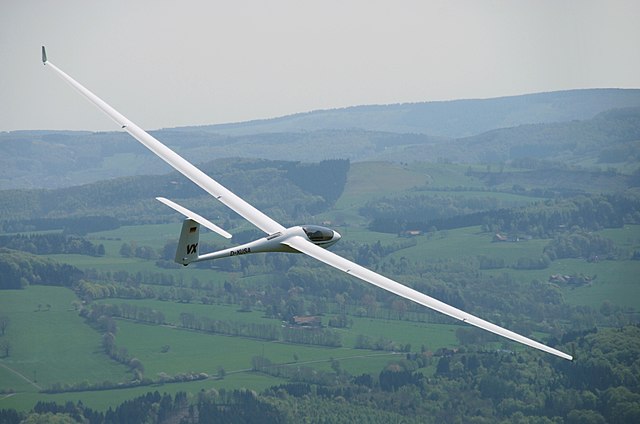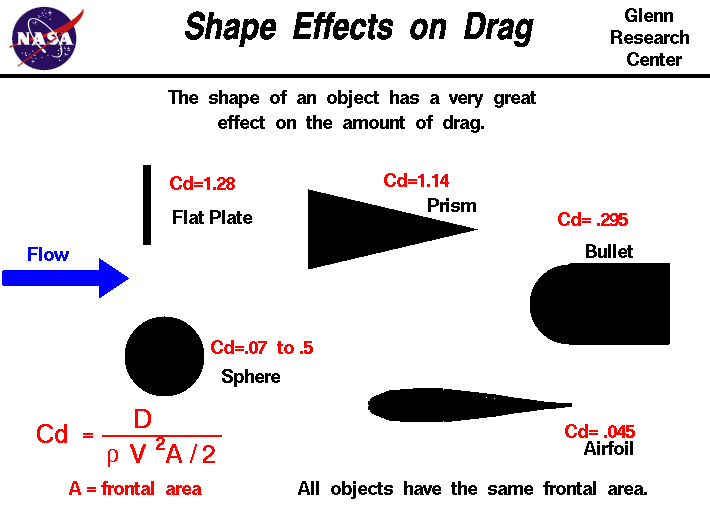RGClark
Mathematician
The lift/drag (L/D) ratio can approach 60 for a modern sailplane:

An ASH 31 glider with very high aspect ratio (AR=33.5) lift-to-drag ratio (L/D 56)
https://en.m.wikipedia.org/wiki/Aspect_ratio_(aeronautics)
The L/D ratio is equal to the glide ratio, which is the ratio of the horizontal length traveled for the vertical drop of a glider. Then by just getting a glider with a 60 L/D ratio to 100 meters, it would be able to glide 6,000 meters, 6 km, horizontal distance.
My idea about how to get a small glider with this high L/D ratio to 100 meters would have the wings first folded up, swung back, and retracted into the fuselage. The fuselage would be given a minimal drag cross-section, such as a tear drop or airfoil shape:

Using the airless approximation, i.e., operating only by gravity, you need about 45 m/s, 160 km/hr, 100 mph, vertical launch speed to reach 100 m altitude. You would need somewhat more than this speed under drag to reach the 100 m height, but the airfoil shape should mean the required speed is still well within the capabilities of a small motor.
After the glider reaches the 100 m altitude, the wings are deployed and the up to 6 km glide range is reached.
Still, I wonder if we can arrange an even larger glide range simply by keeping the glider in its usual configuration and launching at an angle from the ground so you get both altitude and distance from the beginning. The issue though is that eventhough you have high L/D, this will also be accompanied by high drag, when the wings are fully deployed.
So it’s not certain you can get increased range this way. But what would be the optimal angle to maximize distance?
Bob Clark

An ASH 31 glider with very high aspect ratio (AR=33.5) lift-to-drag ratio (L/D 56)
https://en.m.wikipedia.org/wiki/Aspect_ratio_(aeronautics)
The L/D ratio is equal to the glide ratio, which is the ratio of the horizontal length traveled for the vertical drop of a glider. Then by just getting a glider with a 60 L/D ratio to 100 meters, it would be able to glide 6,000 meters, 6 km, horizontal distance.
My idea about how to get a small glider with this high L/D ratio to 100 meters would have the wings first folded up, swung back, and retracted into the fuselage. The fuselage would be given a minimal drag cross-section, such as a tear drop or airfoil shape:

Using the airless approximation, i.e., operating only by gravity, you need about 45 m/s, 160 km/hr, 100 mph, vertical launch speed to reach 100 m altitude. You would need somewhat more than this speed under drag to reach the 100 m height, but the airfoil shape should mean the required speed is still well within the capabilities of a small motor.
After the glider reaches the 100 m altitude, the wings are deployed and the up to 6 km glide range is reached.
Still, I wonder if we can arrange an even larger glide range simply by keeping the glider in its usual configuration and launching at an angle from the ground so you get both altitude and distance from the beginning. The issue though is that eventhough you have high L/D, this will also be accompanied by high drag, when the wings are fully deployed.
So it’s not certain you can get increased range this way. But what would be the optimal angle to maximize distance?
Bob Clark
Last edited:



